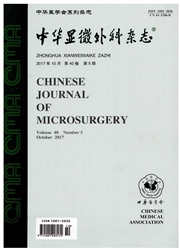

 中文摘要:
中文摘要:
目的探讨臂丛根性撕脱伤的高分辨率磁共振成像特点,为早期诊断臂丛根性撕脱伤提供帮助。方法筛选于2006年2月-2011年2月收治臂丛损伤的病例.术前均行臂丛MRI检查,术中探查证实为臂丛根性撕脱伤45例,总结臂丛根性撕脱伤的高分辨率磁共振表现特点及MR诊断臂丛根性撕脱伤的应用价值。结果臂丛根性撕脱伤的MRI表现为:①创伤性脊膜囊肿最为常见.有42例.出现率为93.3%;②脊髓偏移,有25例,出现率为55.6%;③脊神经前后根消失,有8例,出现率为17.8%;④“黑线”征,有18例,出现率为40.0%。核磁共振对臂丛根性撕脱伤诊断的敏感性为95.7%,特异性为77馏%,准确性为94.6%。结论臂丛根性撕脱伤患者的MRI中以创伤性脊膜囊肿最为常见,可对臂丛损伤的定位诊断及手术治疗提供参考依据。
 英文摘要:
英文摘要:
Objective To discuss the characteristic of brachial plexus root avulsion injury of high resolution MR imaging and the value in diagnosing of brachial plexus root avulsion injury early. Methods Fourty-five cases of brachial plexus root avulsion injury patients had being used for investigation to find the characteristic and diagnostic value of MR image of brachial plexus root avulsion injury., which all have pre-operative MR imaging and were diagnosed brachial plexus root avulsion injury by intra-operative exploration and electrophysiology form February 2006 to February 2011. Results Post-traumatic spinalmeningolceles were seen in 42 cases, the frequency was 93.3%; Displacement of spinal cord was seen in 25 cases, the frequency was 55.6%; Absence of anterior and posterior root of spinal nerve was seen in 8 cases, the frequency was 17.8%; h "Black line sign" was seen in 18 cases, the frequency was 40.0%. The sensitivity, specificity, and accuracy of MRI in diagnosing brachial plexus root injury were 95.7%, 77.8% and 94.6% respectively. Conclusion Posttraumatic spinalmeningolceles are most often seen in MR of brachial plexus root avulsion injury, this sign can play an important role in diagnosing and treatment of brachial plexus root avulsion injury.
 关于刘小林:
关于刘小林:
 关于朱家恺:
关于朱家恺:
 关于傅国:
关于傅国:
 关于顾立强:
关于顾立强:
 同期刊论文项目
同期刊论文项目
 同项目期刊论文
同项目期刊论文
 期刊信息
期刊信息
